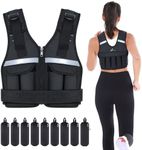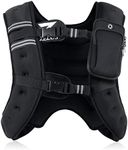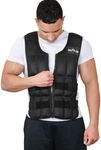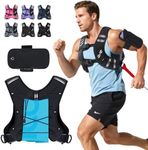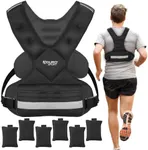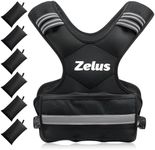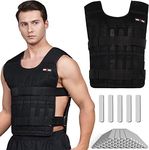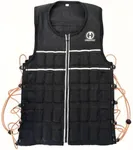Buying Guide for the Best Weight Vests
Choosing the right weight vest can significantly enhance your workout routine by adding resistance and helping you build strength and endurance. When selecting a weight vest, it's important to consider several key specifications to ensure you get the best fit for your needs. Understanding these specs will help you make an informed decision and get the most out of your investment.Weight CapacityWeight capacity refers to the maximum amount of weight the vest can hold. This is important because it determines how much resistance you can add to your workouts. Weight vests typically range from 10 to 100 pounds. For beginners or those looking to add a light challenge, a vest with a lower weight capacity (10-20 pounds) is suitable. Intermediate users might prefer a vest with a capacity of 20-40 pounds, while advanced users or those training for specific sports might opt for vests with higher capacities (50 pounds and above). Consider your current fitness level and workout goals when choosing the weight capacity.
AdjustabilityAdjustability refers to how easily you can change the weight of the vest. This is important because it allows you to increase or decrease the resistance as needed, making the vest versatile for different exercises and fitness levels. Some vests come with fixed weights, while others have removable weights that can be adjusted in small increments. If you plan to use the vest for a variety of workouts or want to gradually increase the resistance, look for a vest with adjustable weights. This will give you more flexibility and allow you to progress at your own pace.
Fit and ComfortFit and comfort are crucial because a poorly fitting vest can cause discomfort and even injury during workouts. A good weight vest should distribute the weight evenly across your torso and have adjustable straps to ensure a snug fit. Look for vests with padded shoulders and breathable materials to enhance comfort, especially if you plan to wear the vest for extended periods. Try on different vests if possible to find one that fits well and feels comfortable during movement. Your body type and the types of exercises you do will influence the best fit for you.
Material and DurabilityThe material and durability of the weight vest are important because they affect the vest's longevity and performance. High-quality materials like reinforced nylon or neoprene are durable and can withstand intense workouts. Additionally, look for vests with double stitching and strong fastenings to ensure they can handle the added weight without tearing or wearing out quickly. If you plan to use the vest frequently or for high-impact activities, investing in a durable vest will save you money in the long run and provide better performance.
Design and MobilityThe design and mobility of the weight vest are important because they affect how easily you can move while wearing it. A well-designed vest should allow for a full range of motion without restricting your movements. Look for vests with a streamlined design that hugs your body and doesn't bounce around during exercise. Some vests are specifically designed for certain activities, such as running or CrossFit, so consider the types of workouts you'll be doing when choosing a design. A vest that allows for good mobility will make your workouts more effective and enjoyable.

